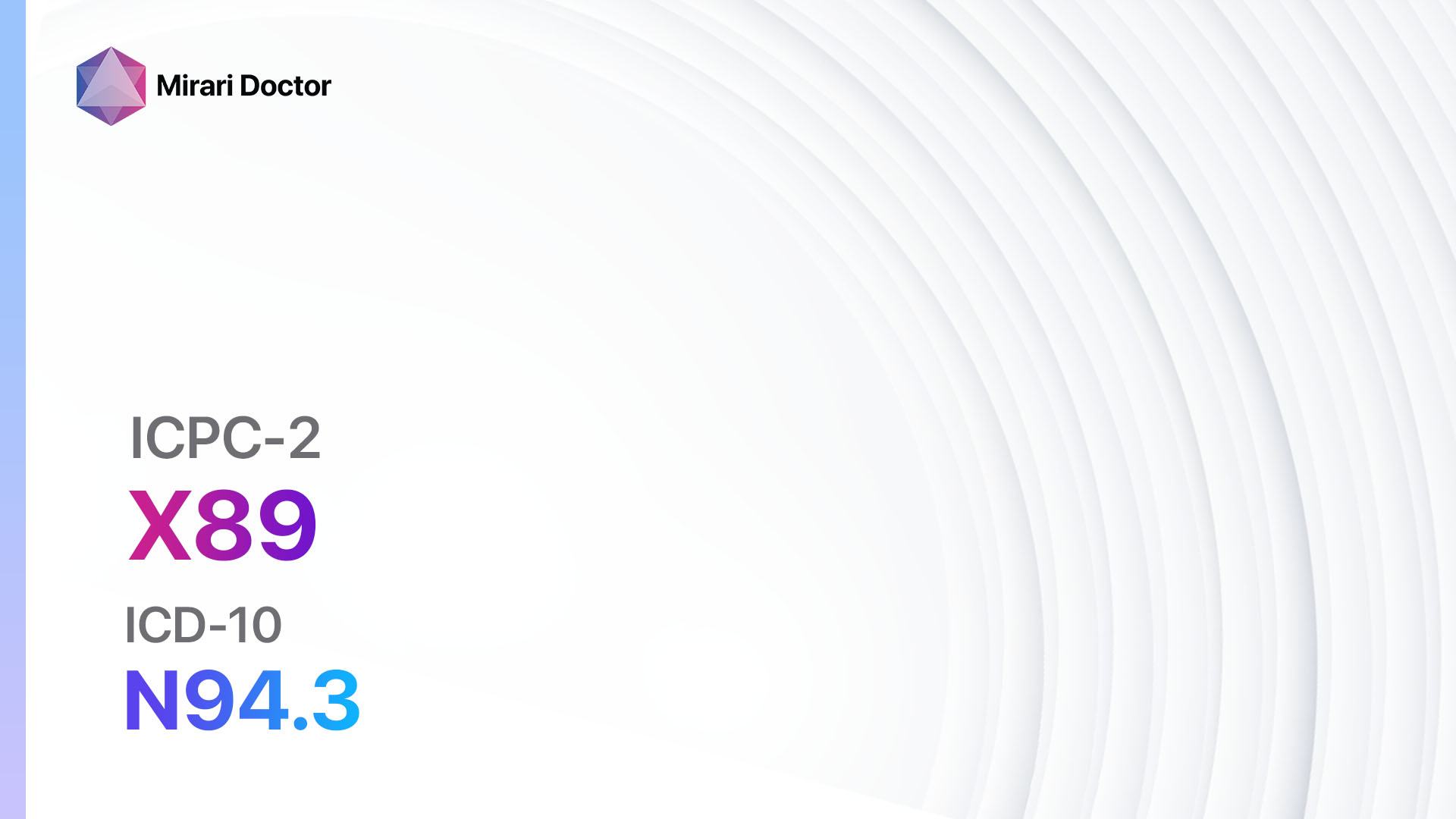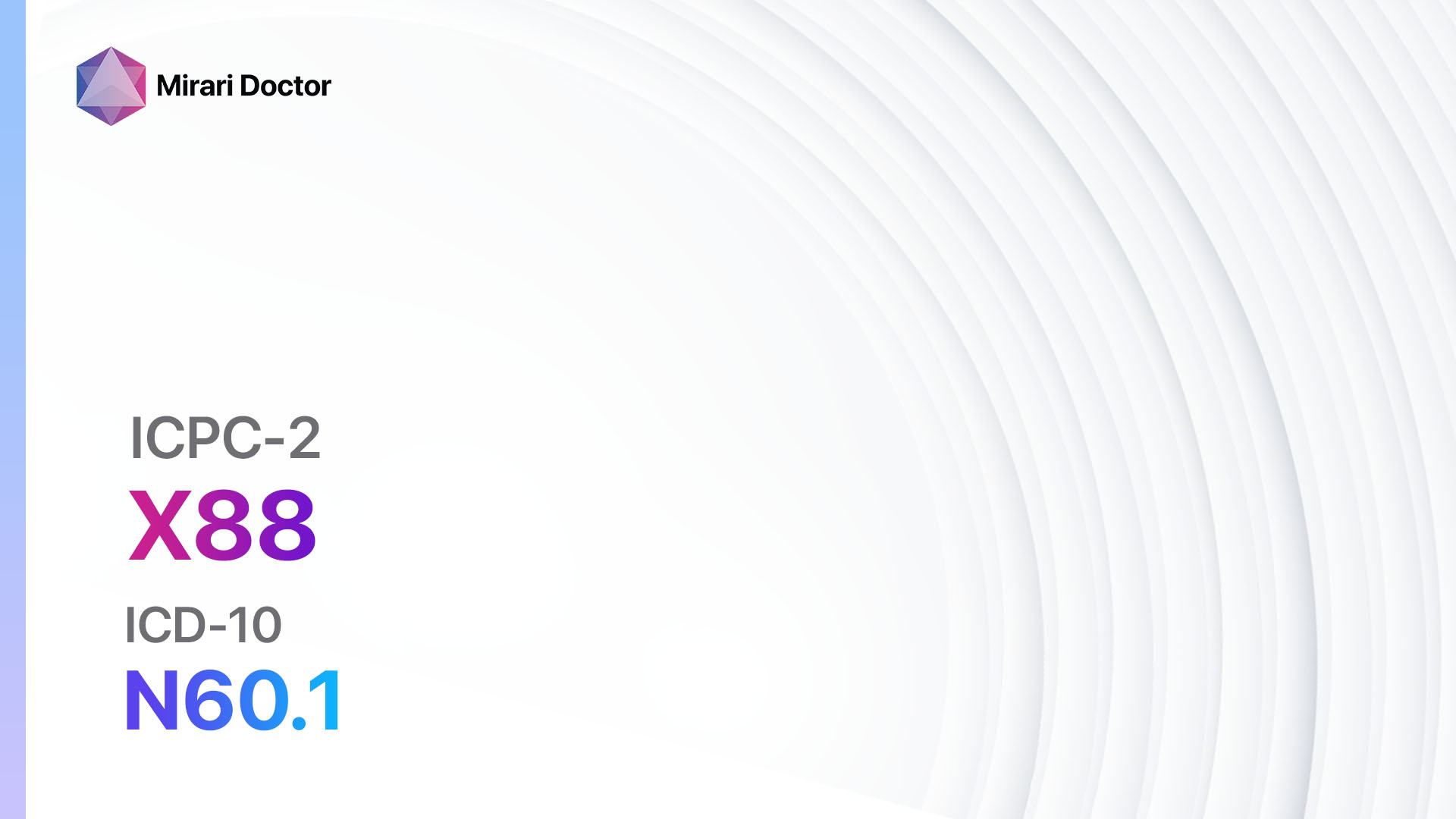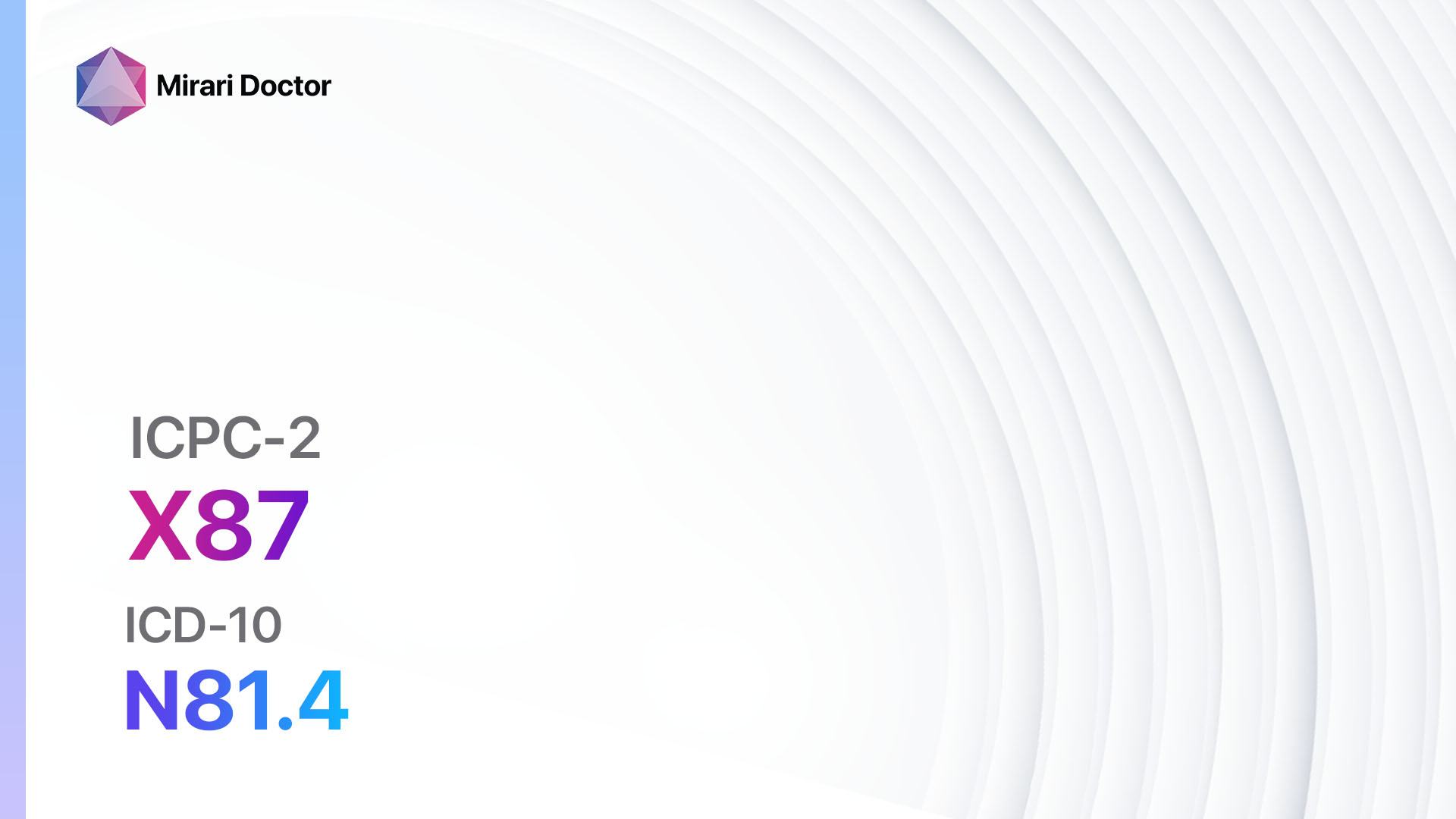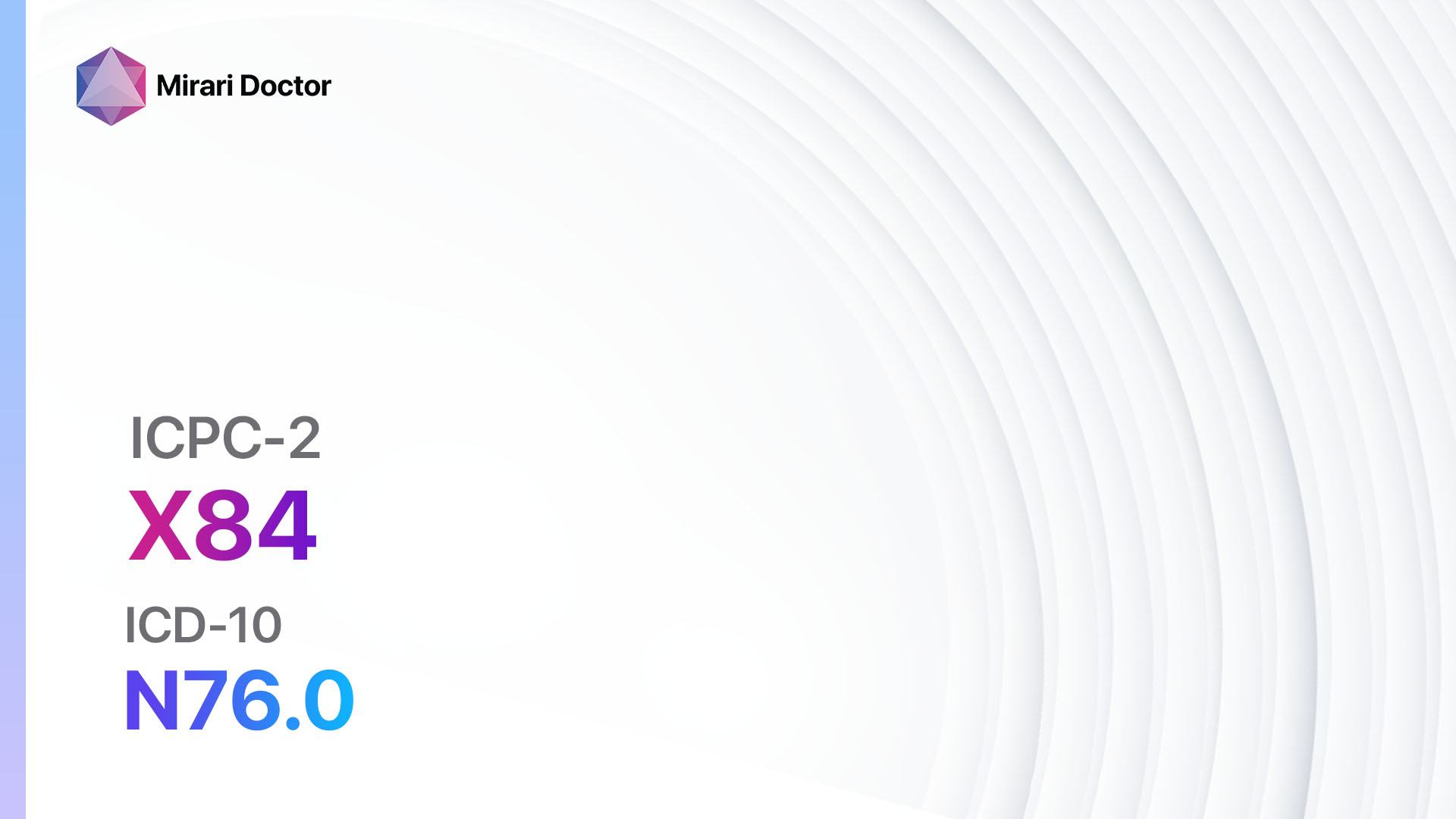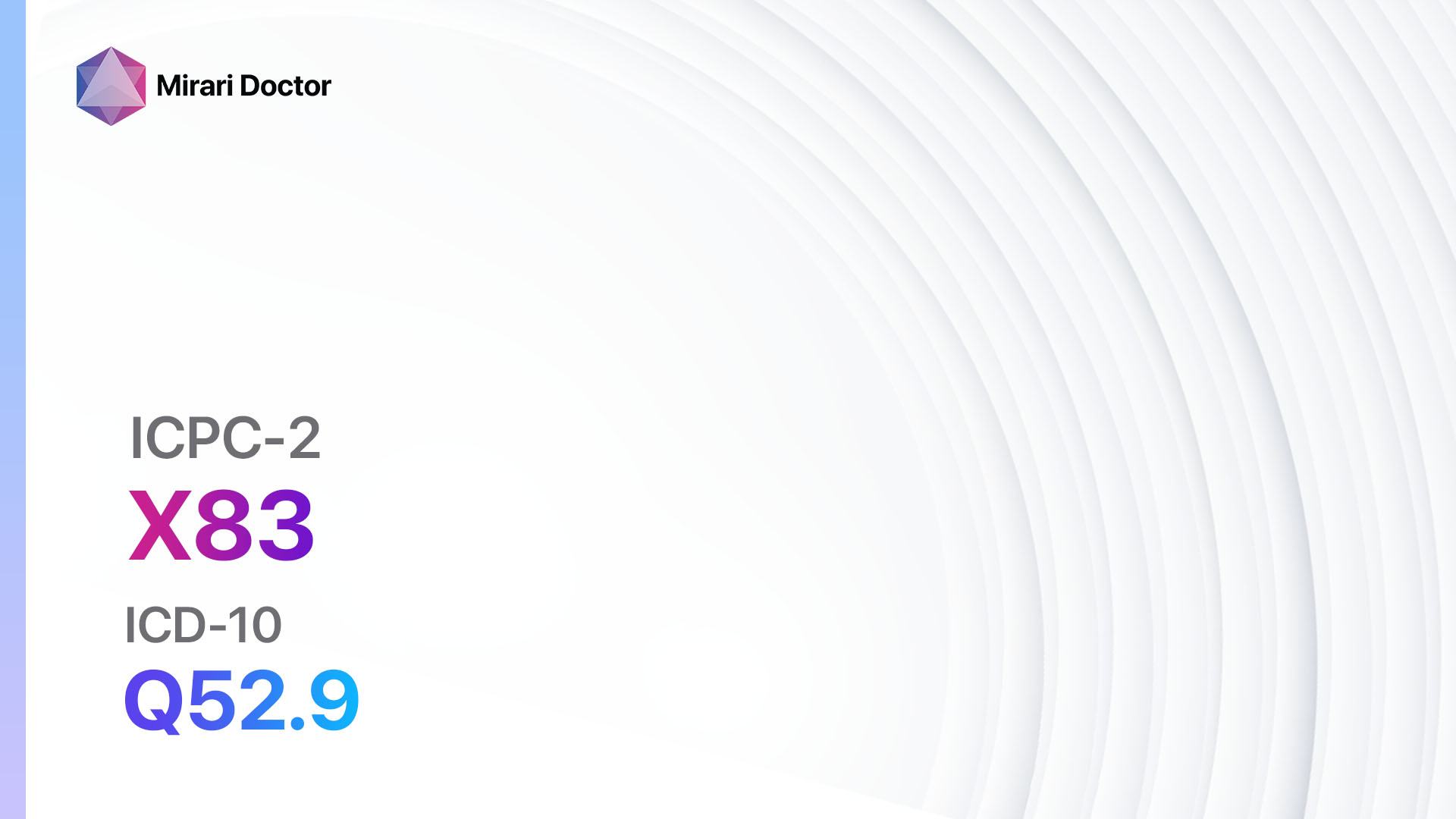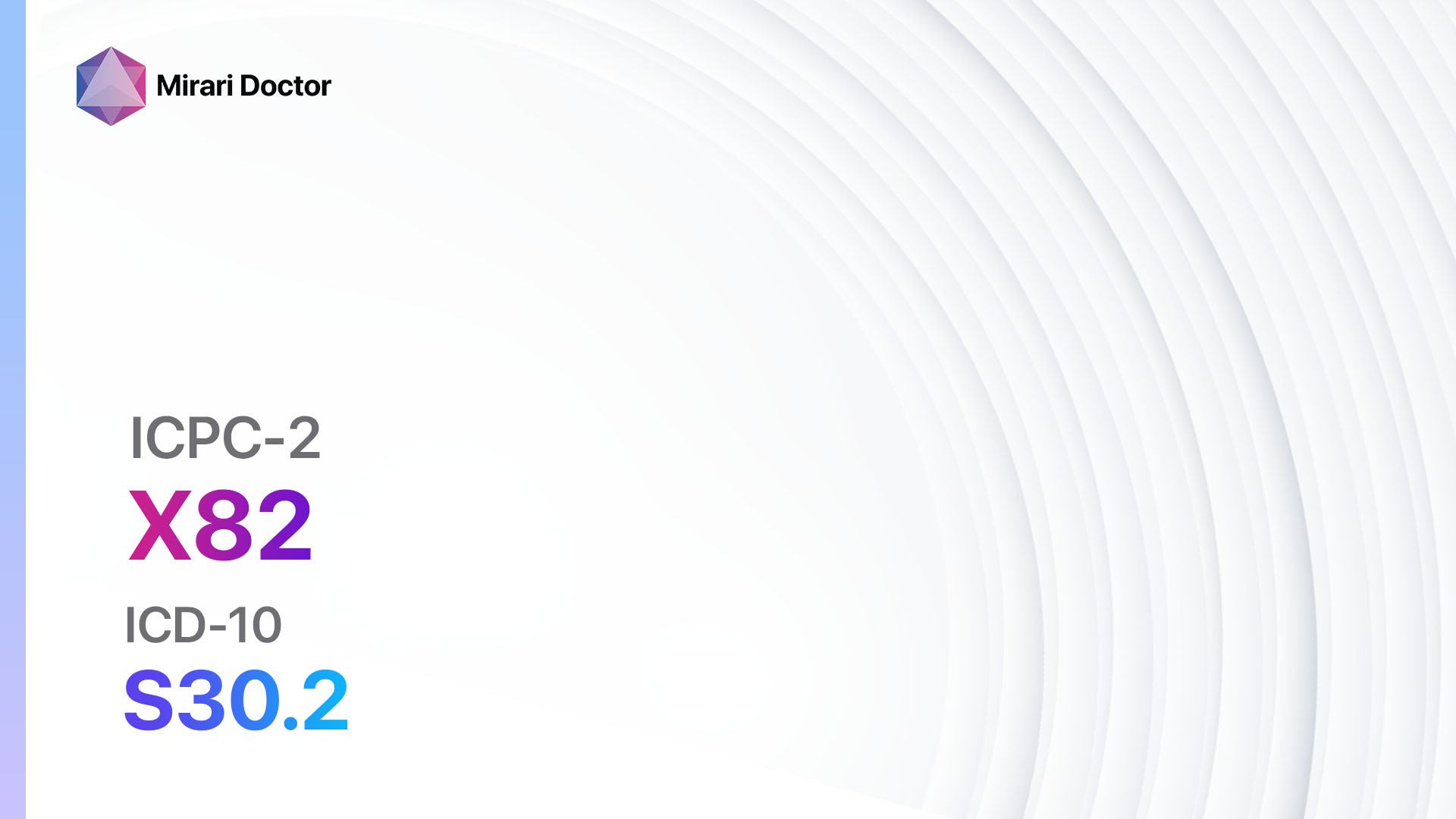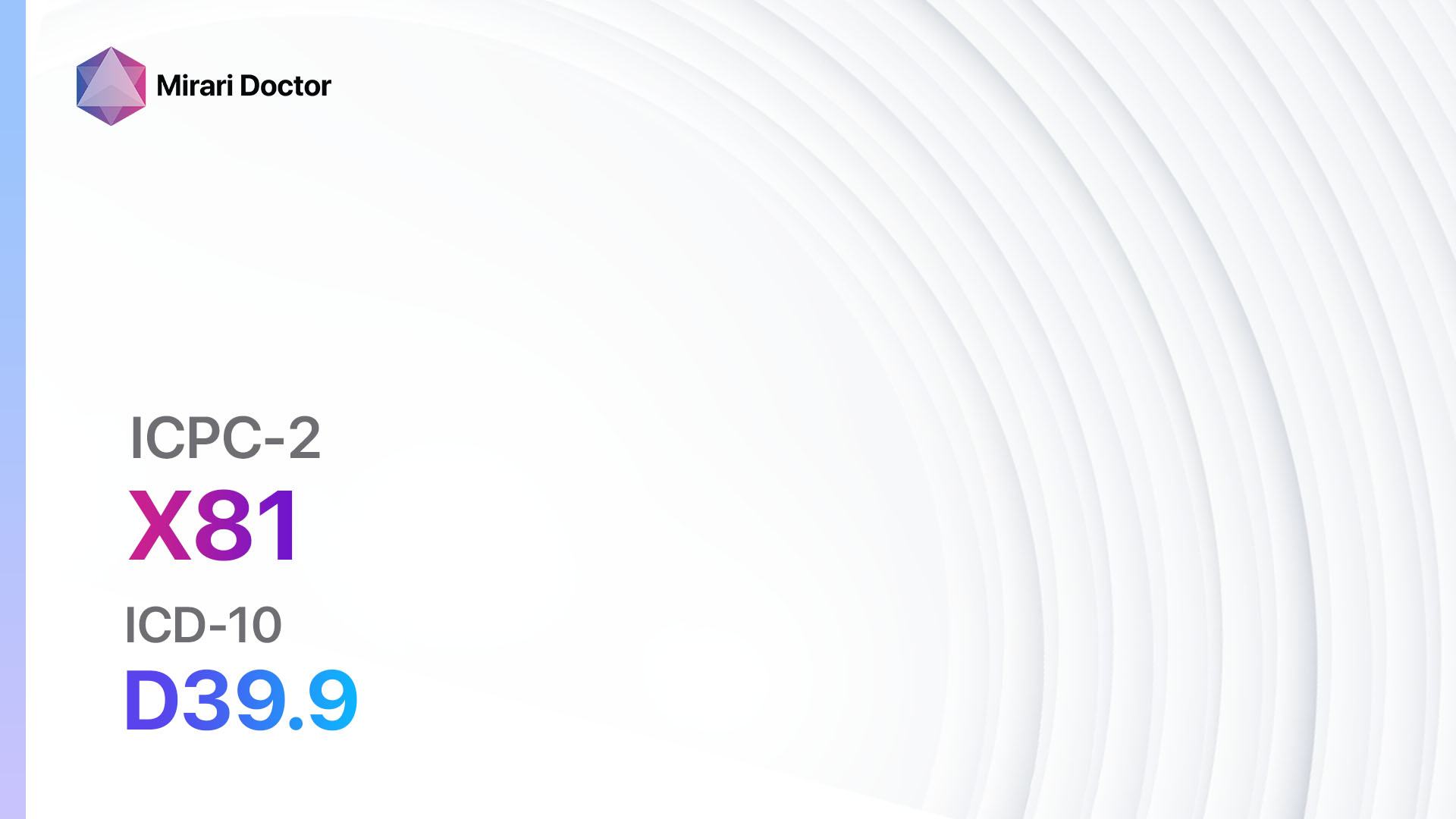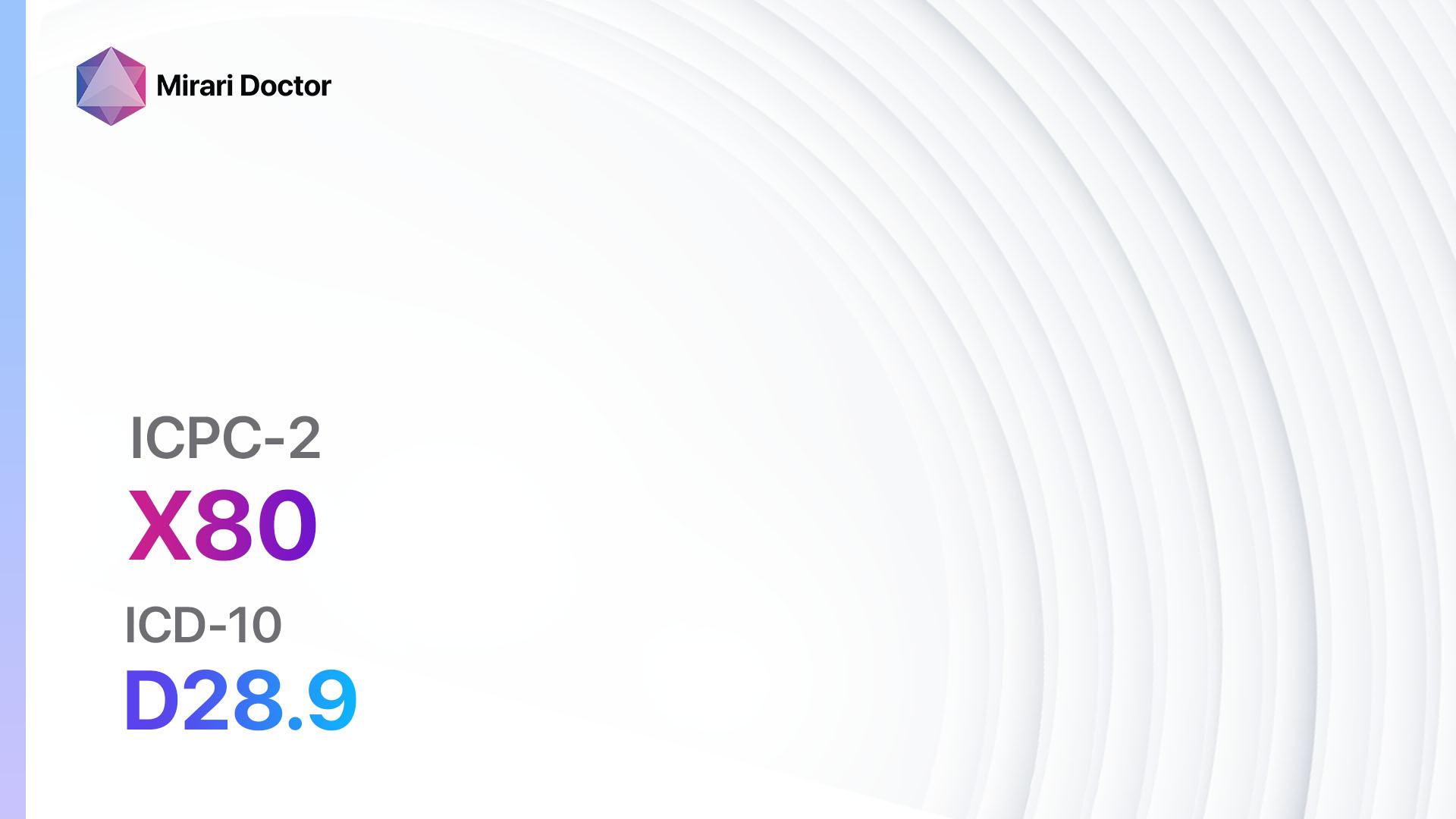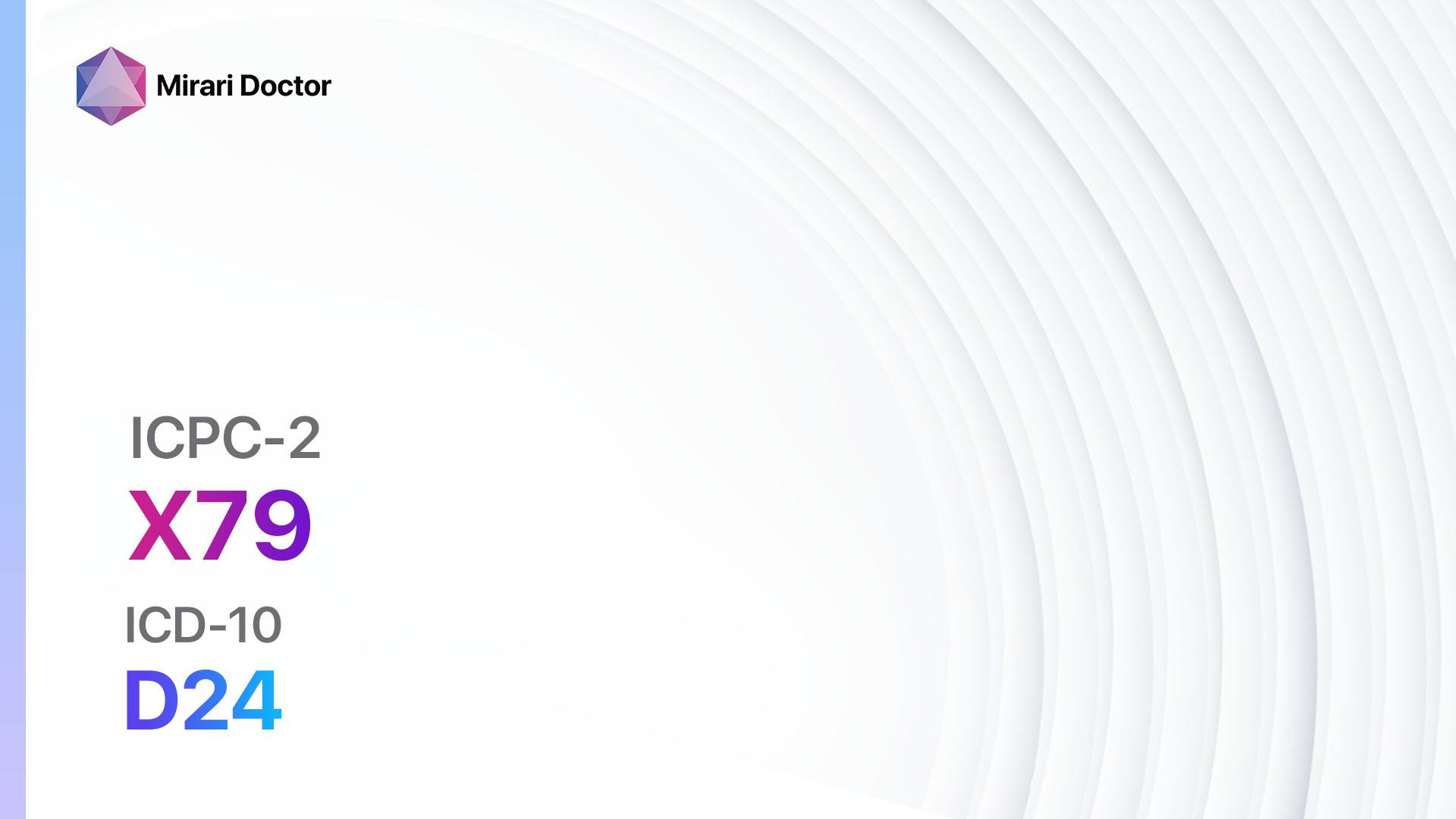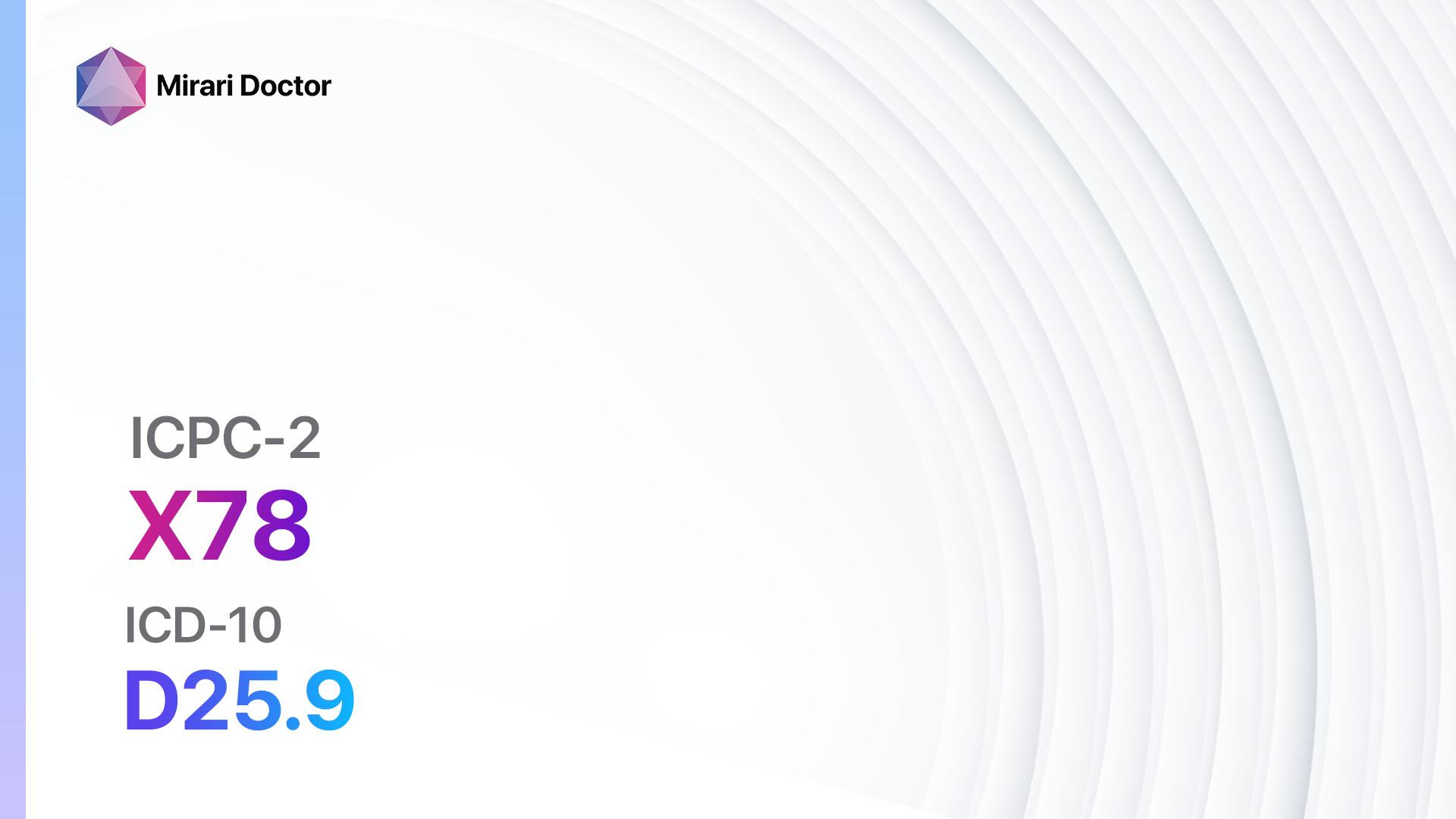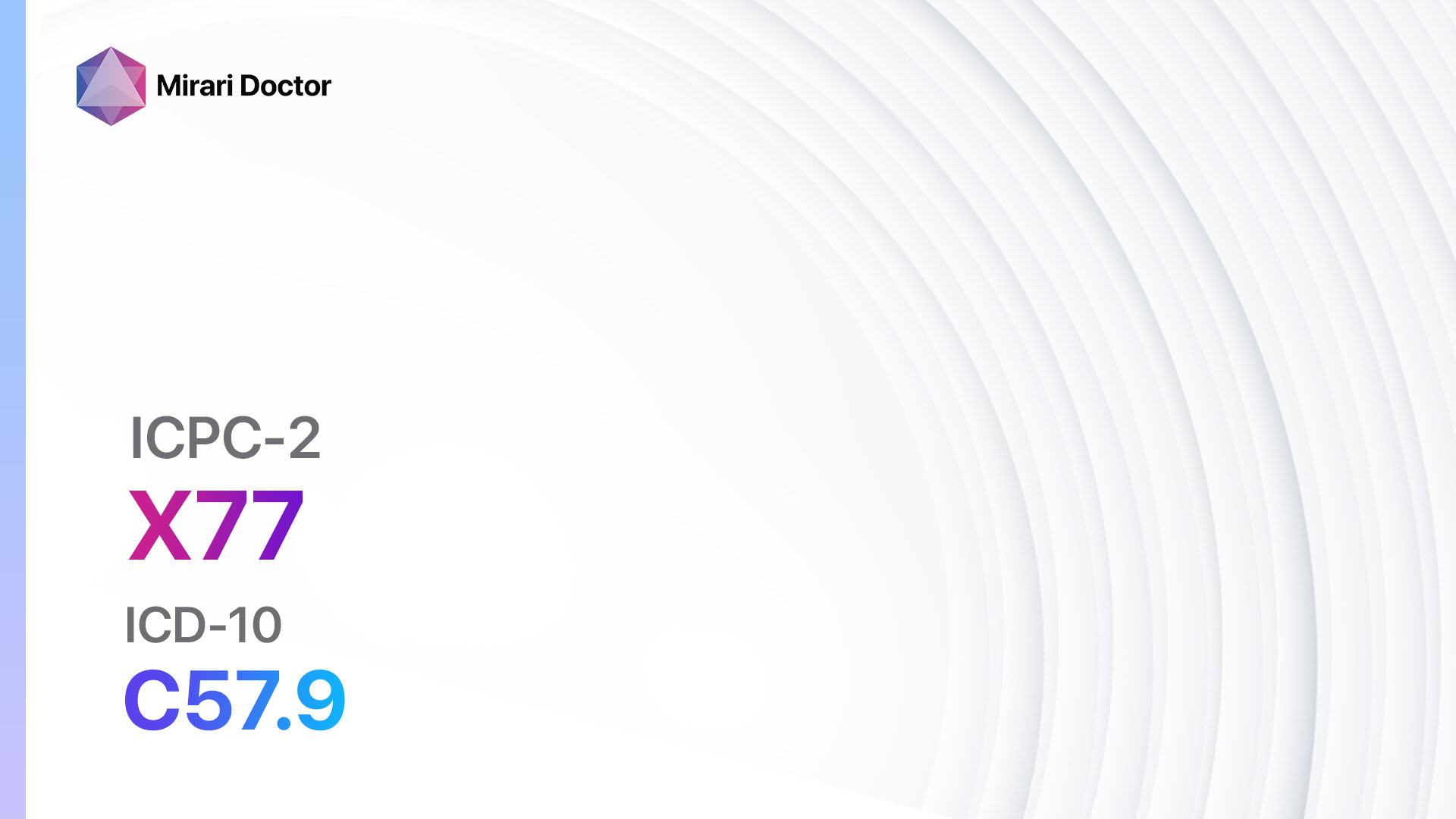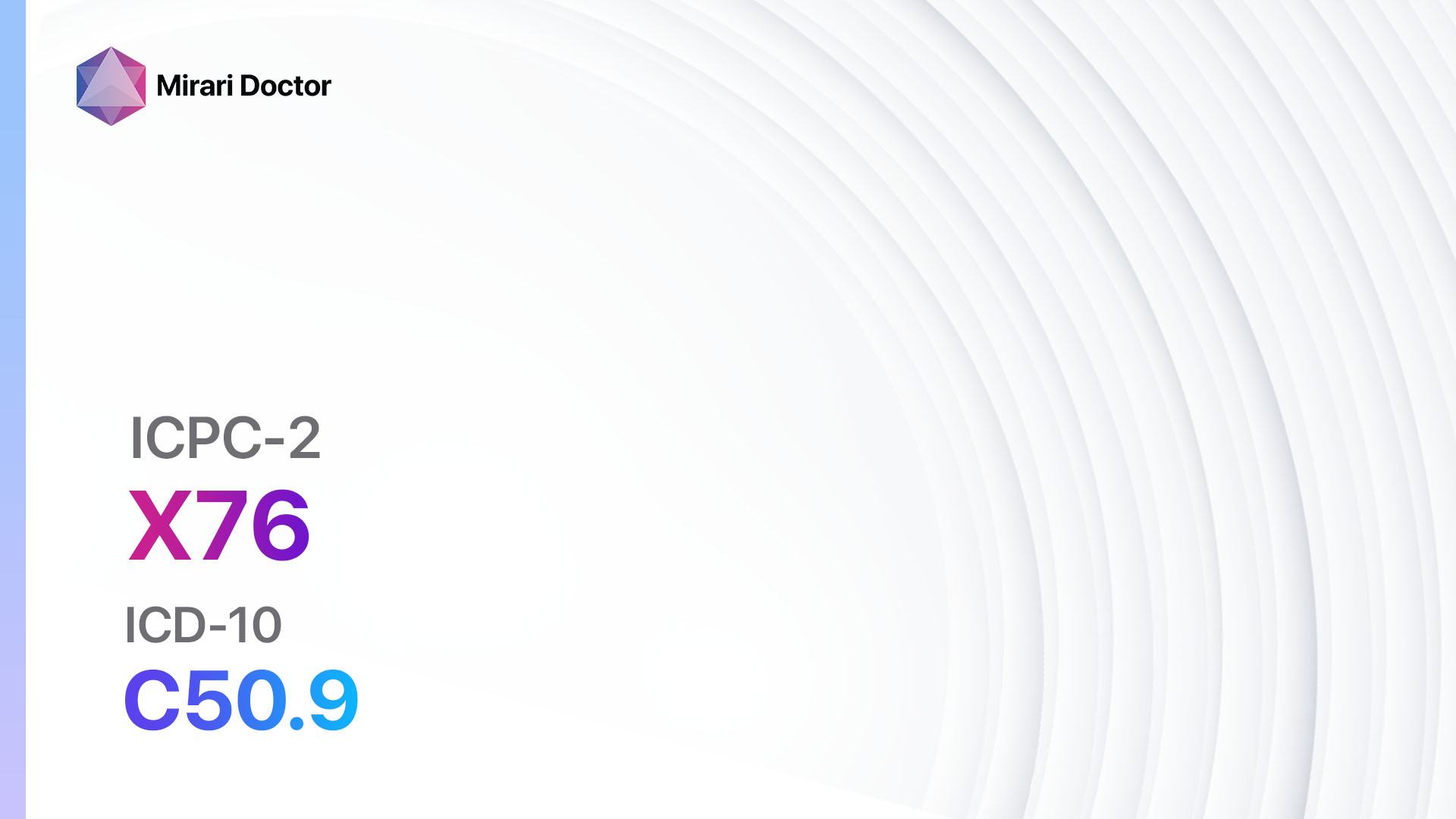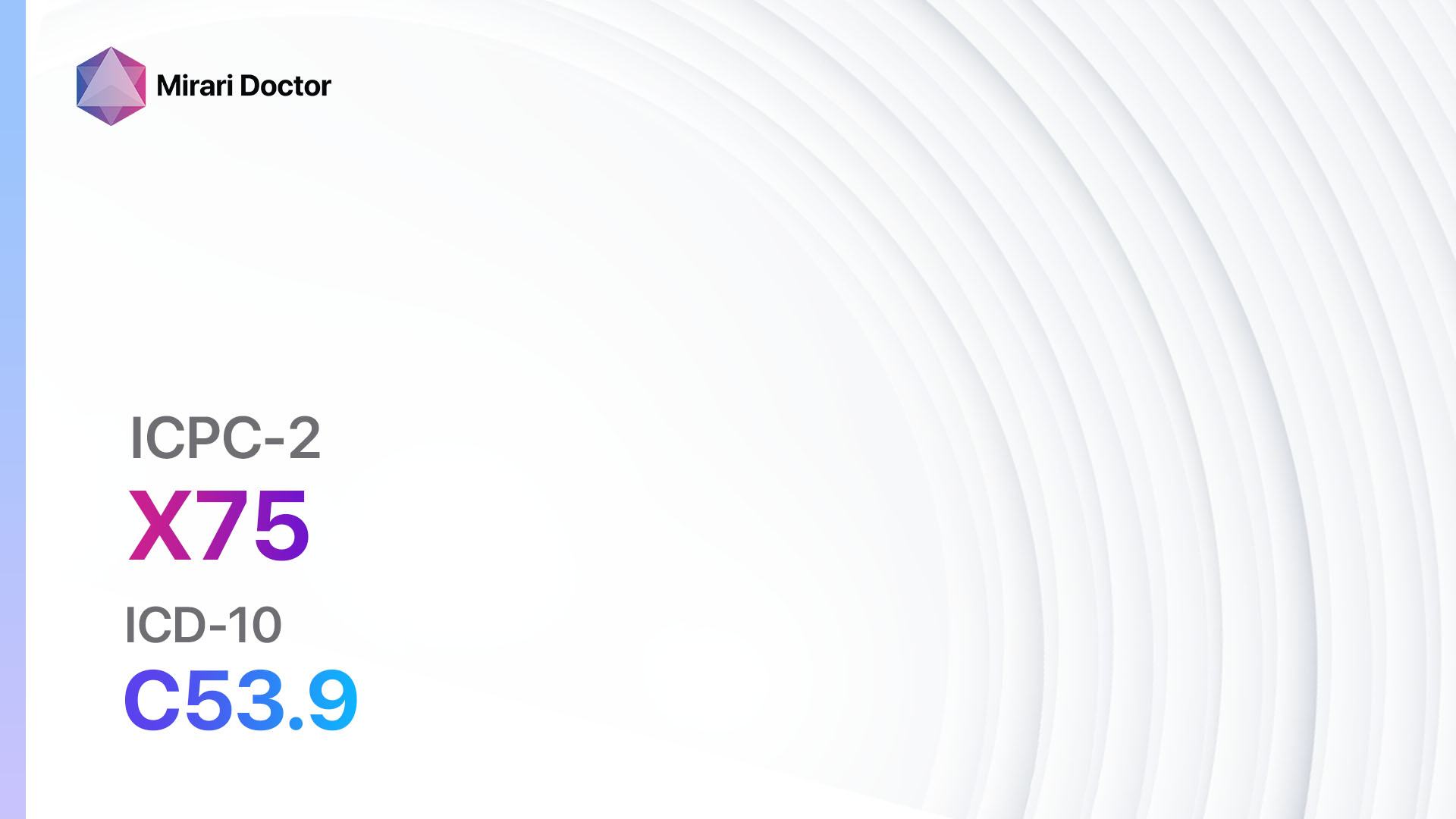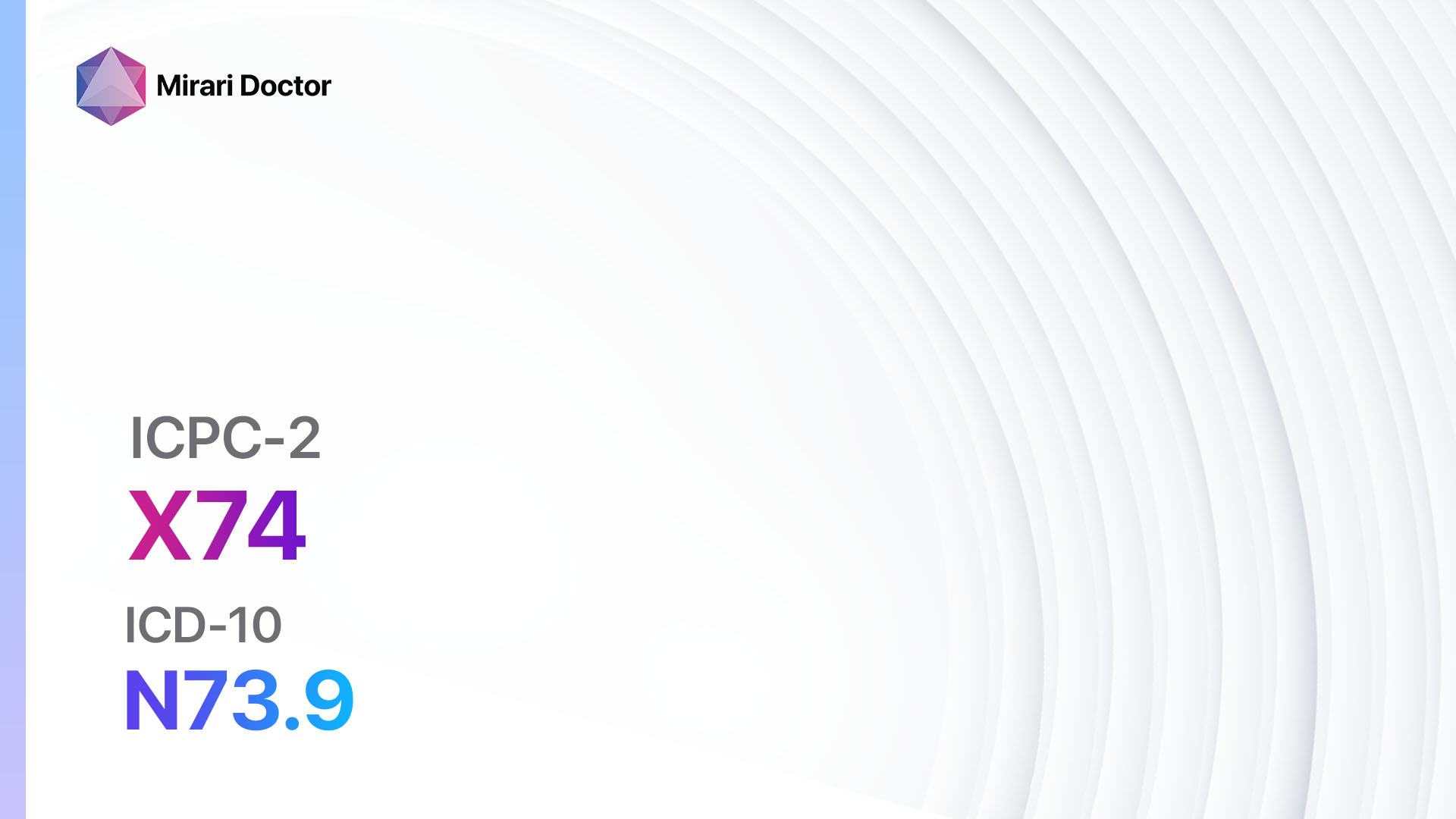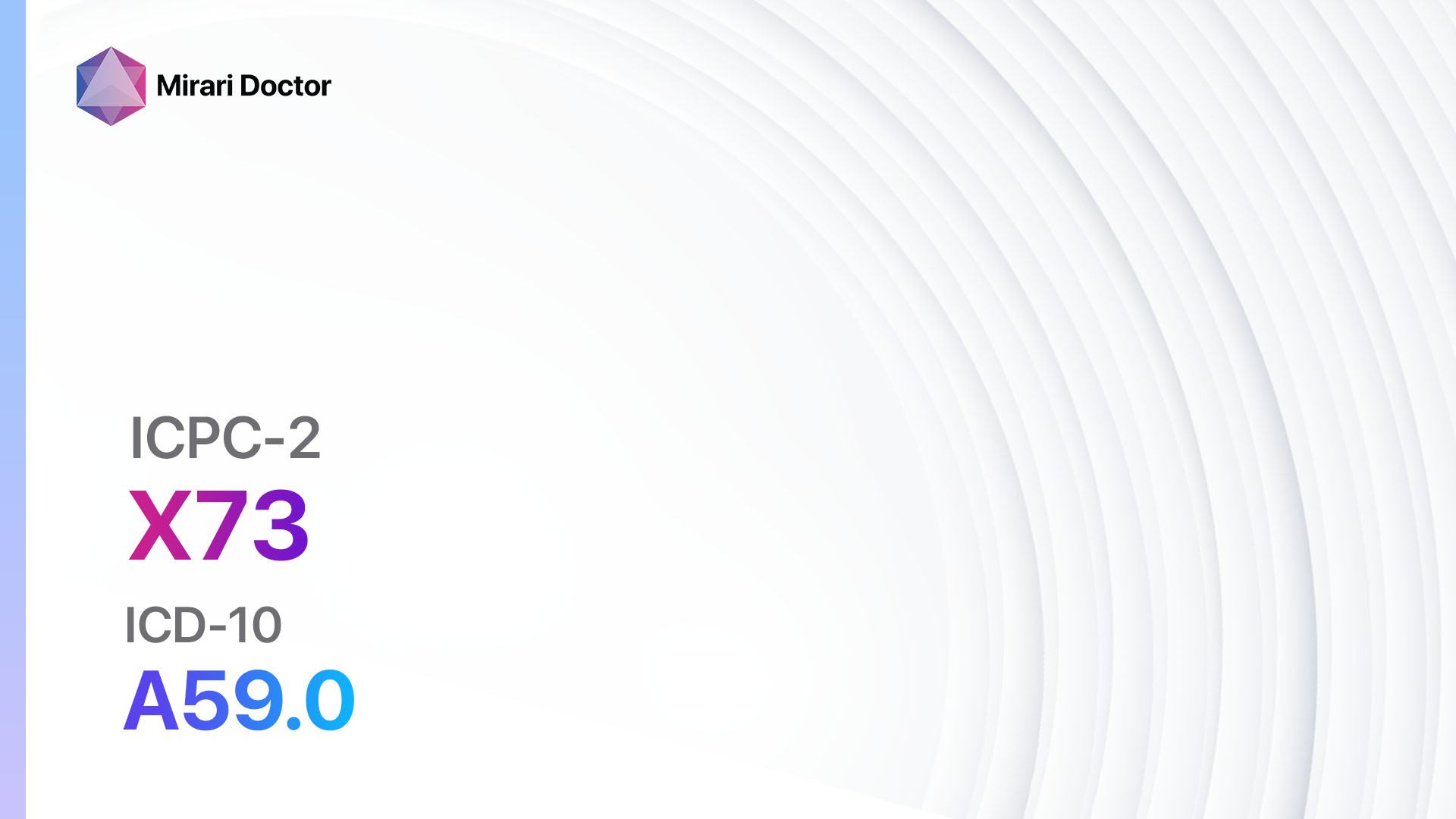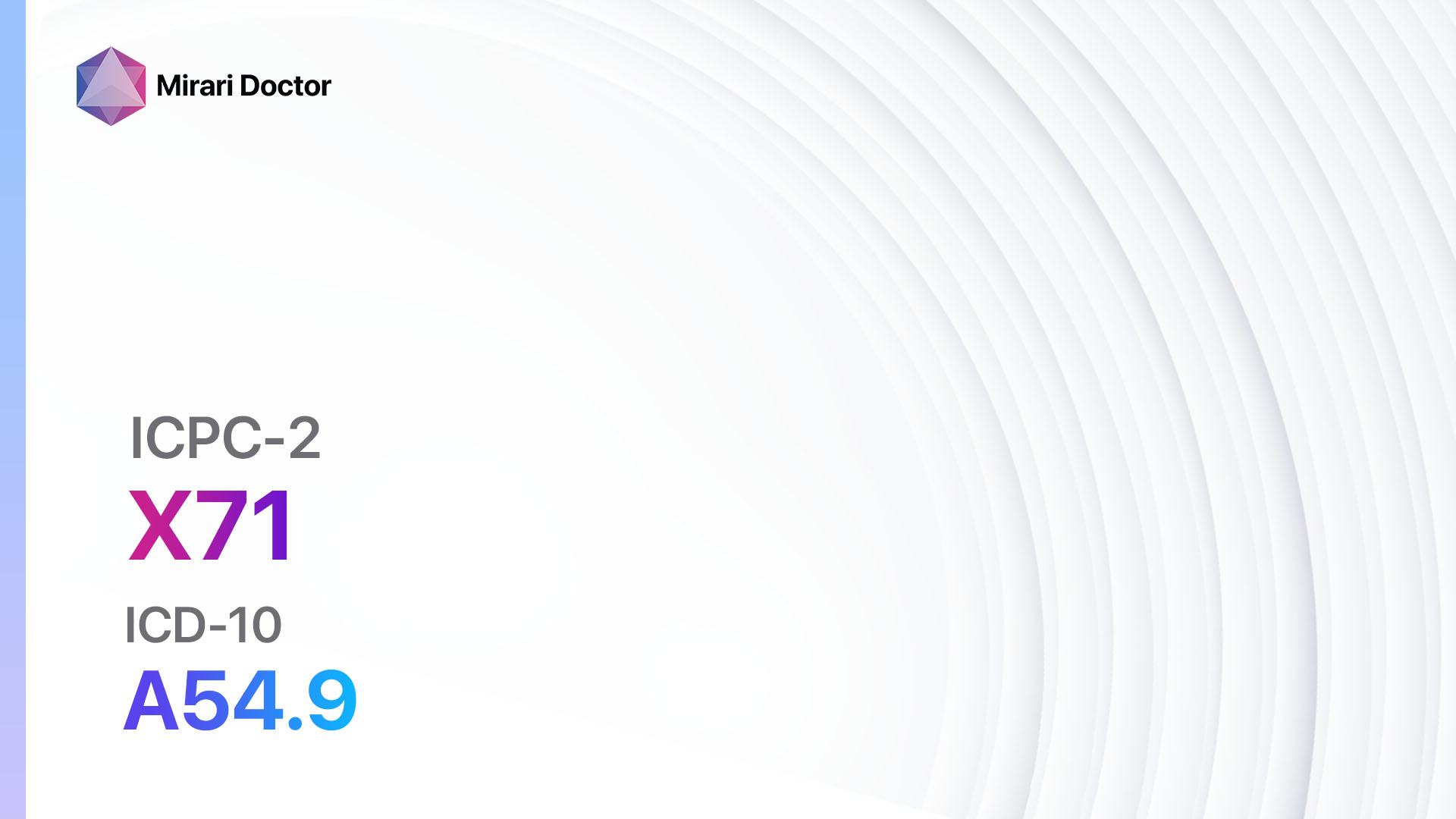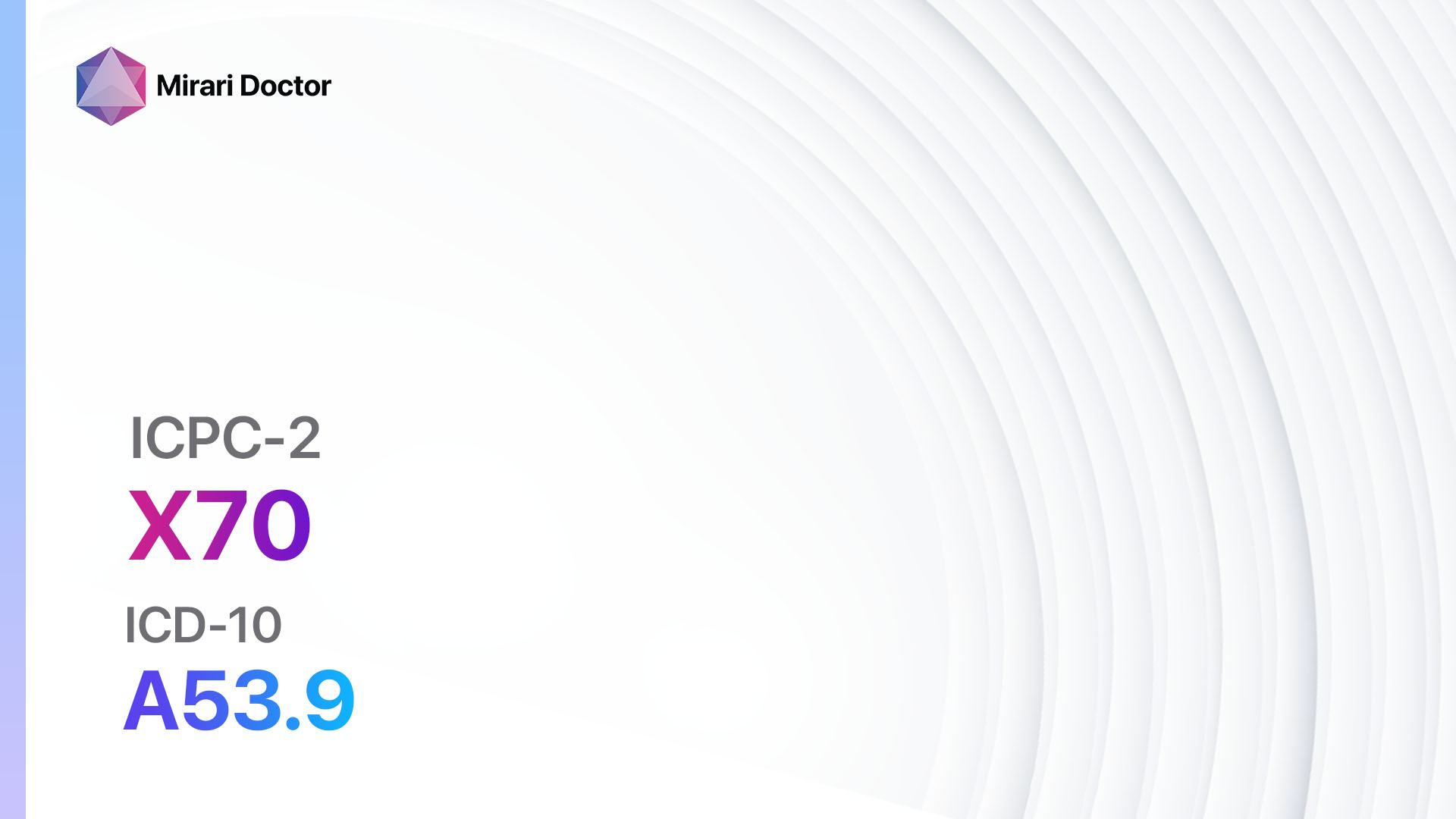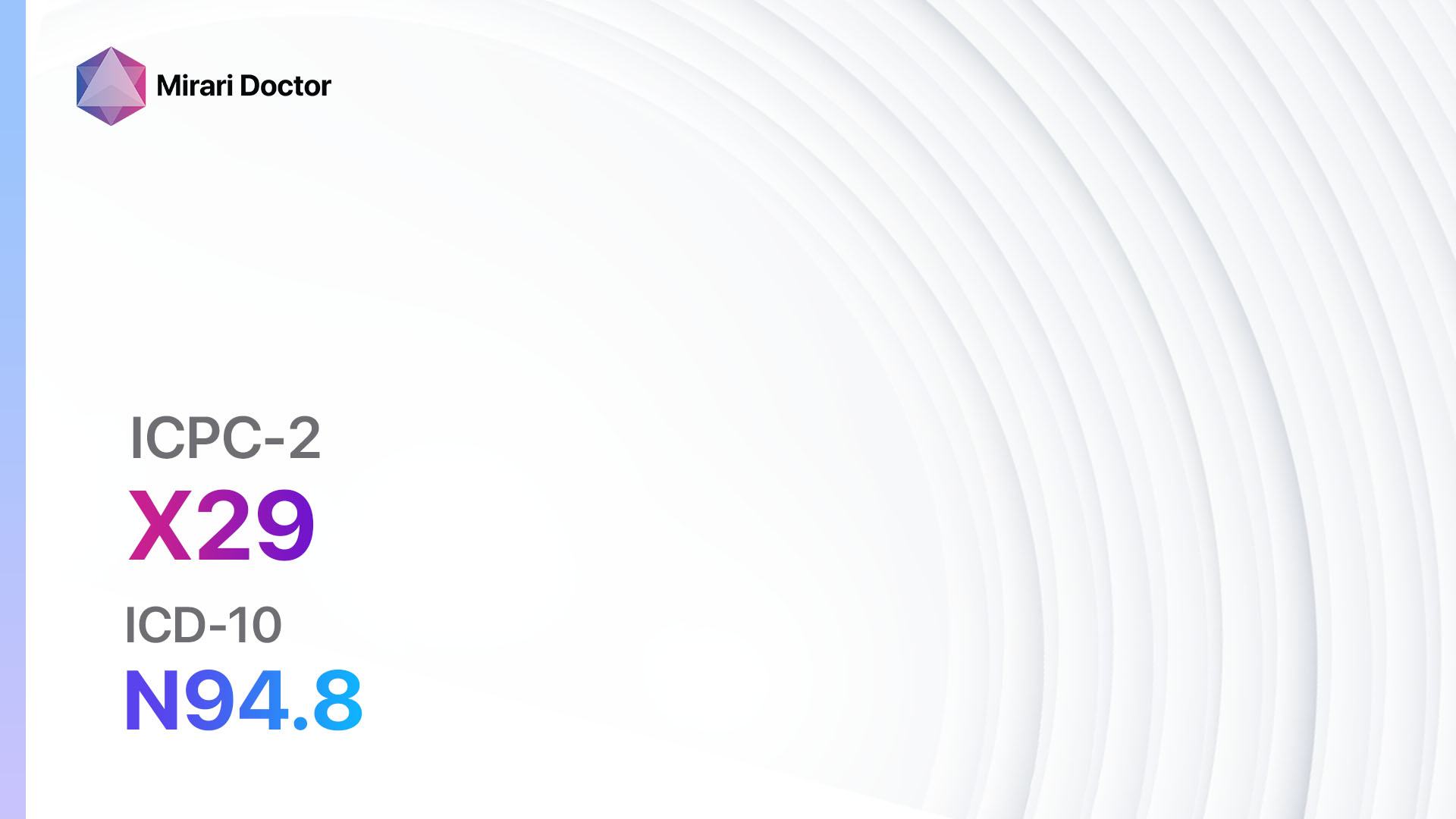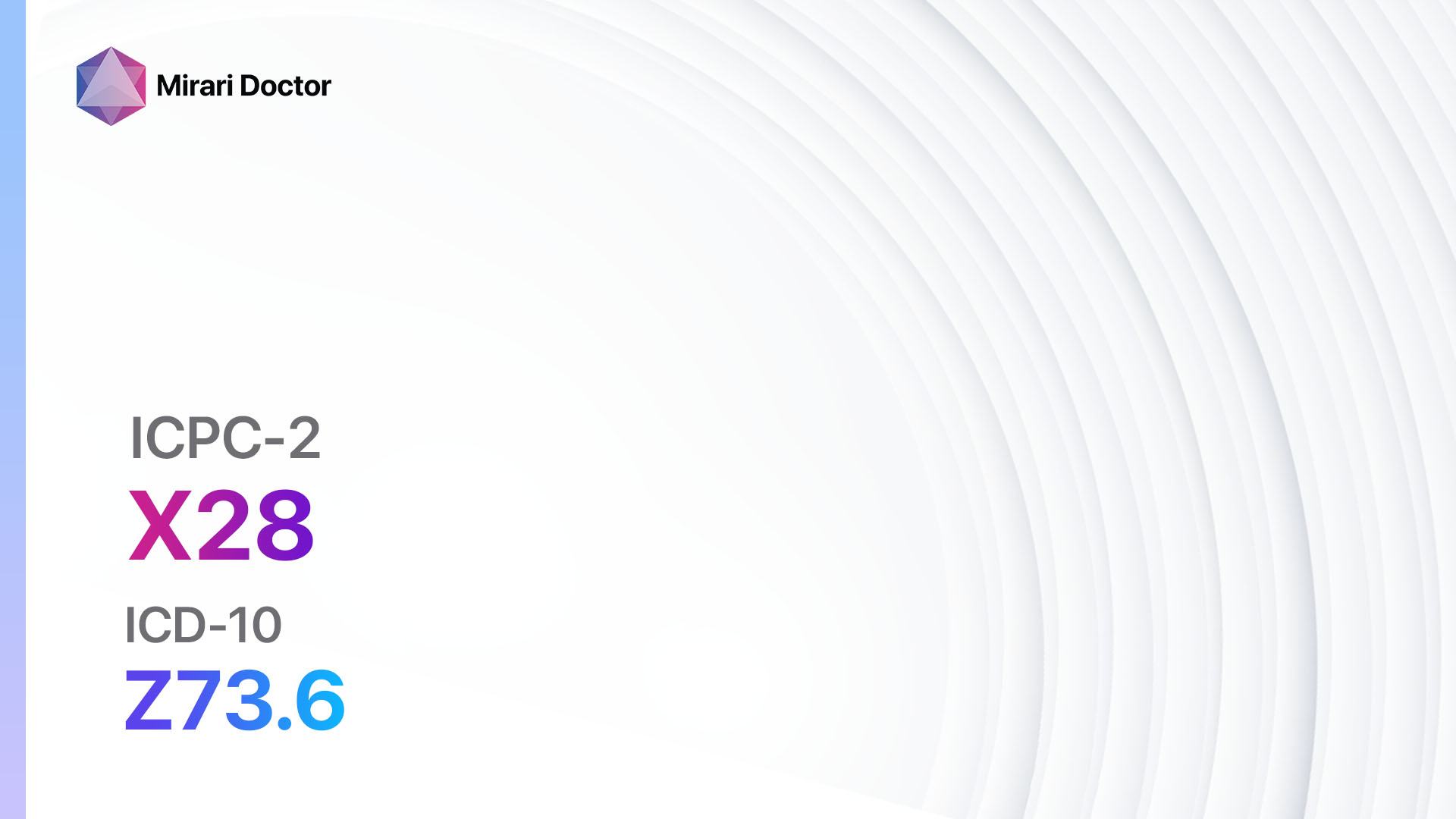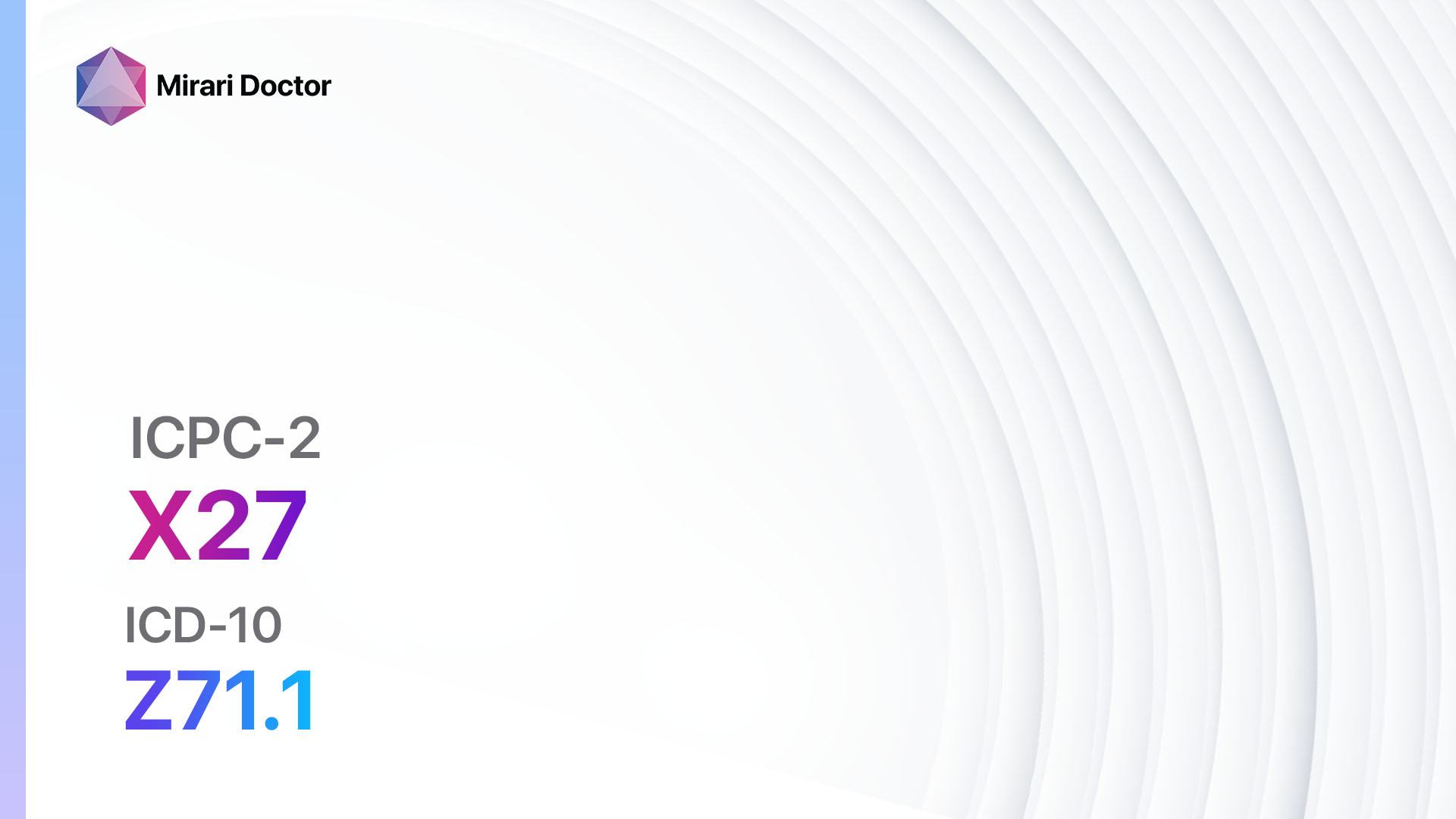
介绍
宫颈疾病 NOS 指的是一种非特异性宫颈疾病的诊断,不属于任何特定类别。为了防止并发症并确保最佳的患者结果,正确诊断和管理这种情况非常重要。本指南旨在为医疗专业人员提供全面的方法来诊断和管理宫颈疾病 NOS。
编码
症状
- 异常阴道出血:这可能包括月经之间的点滴出血、月经过多或过长,或性交后出血。[3]
- 盆腔痛:患者可能会在下腹部或骨盆区域感到疼痛,其程度可以从轻度到严重不等。[4]
- 阴道分泌物:异常分泌物可能是水样的、含血的或有异味。[3]
- 性交疼痛:有些患者在性交时可能会感到疼痛或不适。[5]
- 月经周期的变化:月经不规律或月经出血的持续时间或严重程度的变化。[3]
病因
- 感染:宫颈感染,如细菌性阴道病或性传播感染,可引起炎症并导致宫颈疾病。[6]
- 激素失衡:怀孕或绝经期间等激素水平波动可能会促进宫颈疾病的发展。[7]
- 宫颈创伤:以前的宫颈手术或宫颈创伤会增加患宫颈疾病的风险。[8]
- 慢性炎症:慢性宫颈炎或慢性盆腔炎等状况可导致宫颈疾病。[9]
诊断步骤
病史
- 收集患者的风险因素信息,如性史、避孕药使用情况和既往宫颈手术[10]。
- 询问患者是否有任何症状,包括异常阴道出血、盆腔疼痛或月经周期变化[11]。
- 询问有关任何相关医疗状况的信息,如激素失衡或慢性感染[12]。
体格检查
- 进行盆腔检查以评估宫颈是否有异常,如病变、炎症或分泌物[13]。
- 触诊腹部以检查是否有压痛或可能提示宫颈疾病的肿块[14]。
- 进行窥器检查以可视化宫颈并收集样本以供进一步测试,例如巴氏涂片或宫颈活检[15]。
实验室测试
- 巴氏涂片:筛查测试以检测宫颈异常细胞,这可能表明宫颈疾病[16]。
- HPV 测试:检测人乳头瘤病毒高危毒株的测试,这可能增加宫颈疾病的风险[17]。
- 培养:收集样本进行细菌或病毒培养,以识别可能导致宫颈疾病的感染[18]。
诊断成像
- 经阴道超声:这种成像方式可以提供宫颈及周围结构的详细图像,以评估是否有任何异常[19]。
- 磁共振成像 (MRI):在某些情况下,可以订购 MRI 以进一步评估宫颈疾病的程度或检查是否蔓延到附近结构[20]。
其他测试
- 阴道镜检查:一种使用阴道镜检查宫颈细节并在必要时收集活检的程序[21]。
- 宫颈刮宫:从子宫颈管采集样本以进行进一步评估的程序[22]。
- 锥形活检:切除从宫颈取下一个锥形组织进行检查的手术程序[23]。
随访和患者教育
- 安排定期随访以监测宫颈疾病的进展评估治疗效果[24]。
- 向患者提供有关定期筛查的重要性的信息,例如巴氏涂片,以便及早发现宫颈疾病[25]。
- 讨论未经治疗的宫颈疾病的潜在并发症,如不孕或宫颈癌的发展[26]。
可能的干预措施
传统干预措施
药物治疗:
宫颈疾病 NOS 的前 5 种药物:
- 抗生素(例如,阿奇霉素,多西环素)[27]:
- 成本:仿制药版本可能为每月 $3-$50 。
- 禁忌症:对抗生素过敏,肝病。
- 副作用:恶心,腹泻,皮疹。
- 严重副作用:严重过敏反应,肝毒性。
- 药物相互作用:华法林,口服避孕药。
- 警告:按规定完成整个疗程的抗生素。
- 非甾体抗炎药 (NSAIDs)(例如,布洛芬,萘普生)[28]:
- 成本:仿制药版本通常低于 $10/月。
- 禁忌症:活动性消化性溃疡病,胃肠出血史。
- 副作用:胃部不适,烧心,头晕。
- 严重副作用:胃肠道出血,肾脏问题。
- 药物相互作用:阿司匹林,抗凝药。
- 警告:与食物一起服用以减少胃部不适的风险。
- 激素治疗(例如,口服避孕药,激素替代疗法)[29]:
- 成本:因具体药物和保险覆盖范围而异。
- 禁忌症:血栓史,肝病。
- 副作用:恶心,乳房压痛,情绪变化。
- 严重副作用:血栓,中风,心脏病发作。
- 药物相互作用:抗生素,抗惊厥药。
- 警告:在开始激素治疗之前与患者讨论风险和益处。
- 抗病毒药物(例如,阿昔洛韦,伐昔洛韦)[30]:
- 成本:仿制药版本可能为每月 $10-$50 。
- 禁忌症:对抗病毒药物过敏,肾病。
- 副作用:恶心,头痛,头晕。
- 严重副作用:过敏反应,肾损害。
- 药物相互作用:丙磺舒,其他抗病毒药物。
- 警告:按规定服用并完成整个疗程。
- 免疫调节剂(例如,咪喹莫特)[31]:
- 成本:每月 $100-$500 。
- 禁忌症:对免疫调节剂过敏,自身免疫病。
- 副作用:局部皮肤反应,类似流感症状。
- 严重副作用:严重的皮肤反应,过敏反应。
- 药物相互作用:无报道。
- 警告:在免疫系统受损的患者中慎用。
替代药物:
-
- 局部皮质类固醇:可用于减少炎症和缓解症状[32]。
- 抗真菌药物:如果怀疑有真菌感染,可能会开具抗真菌药物
[33]。
- 抗抑郁药:在某些情况下,可以使用抗抑郁药来管理与宫颈疾病相关的慢性疼痛
[34]。
- 免疫抑制剂:对于自体免疫相关的宫颈疾病患者,可能会考虑免疫抑制药物
[35]。
外科手术:
-
- 宫颈锥切术:一种外科手术,以切除宫颈的锥形组织进行进一步检查
[36]。
-
-
- 费用:$5,000-$10,000。
- 冷冻手术:通过冷冻来破坏异常的宫颈组织
-
[37]。
-
-
- 费用:$2,000-$5,000。
- 激光手术:使用激光移除或破坏异常的宫颈组织
-
[38]。
-
-
- 费用:$3,000-$8,000。
- 电圈手术(LEEP):使用电流加热的细线圈切除异常宫颈组织
-
[39]。
-
-
- 费用:$3,000-$7,000。
- 子宫切除术:在严重情况下或其他治疗失败时,可能建议进行子宫和宫颈的切除
-
[40]。
-
- 费用:$10,000-$20,000。
替代性干预措施
-
- 针灸:可能有助于缓解疼痛和促进放松
[41]。
-
-
- 费用:每次$60-$120。
- 草药补品:某些草药补品,例如绿茶提取物或姜黄素,可能具有抗炎特性
-
[42]。
-
-
- 费用:因具体补品而异。
- 身心技术:如冥想、瑜伽或太极等技术可能有助于减轻压力和改善整体健康
-
[43]。
-
-
- 费用:因具体实践和地点而异。
- 饮食调整:鼓励以富含水果、蔬菜和全谷物的健康饮食,支持整体健康和免疫功能
-
[44]。
-
-
- 费用:因个别食物选择而异。
- 物理治疗:骨盆底物理治疗可能对有骨盆疼痛或肌肉功能障碍的患者有益
-
[45]。
-
- 费用:每次$100-$200。
生活方式干预
-
- 戒烟:吸烟与宫颈疾病风险增加有关。鼓励患者戒烟,以改善整体健康并减少疾病进展
[46]。
-
-
- 费用:因具体戒烟计划或辅助工具而异。
- 健康体重管理:通过饮食和锻炼保持健康体重,帮助降低宫颈疾病风险并改善整体健康
-
[47]。
-
-
- 费用:因个别食物选择和健身会员费而异。
- 安全性行为:鼓励使用屏障方法,如安全套,以减少导致宫颈疾病的性传播感染风险
-
[48]。
-
-
- 费用:因屏障方法的费用而异。
- 压力管理:长期压力可能对免疫功能产生负面影响并增加疾病进展风险。鼓励使用压力管理技术,如正念或放松练习
-
[49]。
-
- 费用:因具体压力管理技术而异。
需要注意的是,提供的费用范围是近似值,可能因地点和干预措施的可用性而有所不同。医疗专业人员在推荐宫颈疾病 (NOS) 干预措施时,应考虑个别患者的需求、偏好和经济状况。
Mirari冷等离子体替代干预
理解Mirari冷等离子体
- 安全且无创的治疗:Mirari冷等离子体是一种安全且无创的治疗选择,用于各种皮肤疾病。它不需要切开,从而降低了疤痕、出血或组织损伤的风险。
- 高效的异物提取:Mirari冷等离子体通过降解和分解有机物质来促进皮肤异物的去除,从而使得更易接近和提取。
- 疼痛减轻和舒适:Mirari冷等离子体具有局部镇痛效果,在治疗时提供疼痛缓解,使患者感到更舒适。
- 感染风险降低:Mirari冷等离子体具有抗菌特性,有效杀灭细菌,降低感染风险。
- 加速愈合和最小化疤痕:Mirari冷等离子体刺激伤口愈合和组织再生,减少愈合时间并最大程度地降低疤痕形成。
Mirari冷等离子体处方
使用Mirari冷等离子体设备的视听指南 – X85宫颈疾病NOS (ICD-10:N88.9)
| 轻度 | 中度 | 重度 |
| 模式设置:1(感染) 位置:0(局部) 早上: 15 分钟, 晚上: 15 分钟 |
模式设置:1(感染) 位置:0(局部) 早上: 30 分钟, 午餐: 30 分钟, 晚上: 30 分钟 |
模式设置:1(感染) 位置:0(局部) 早上: 30 分钟, 午餐: 30 分钟, 晚上: 30 分钟 |
| 模式 设置: 2(愈合) 位置: 0(局部) 早上:15 分钟, 晚上:15 分钟 |
模式 设定:2(伤口愈合) 位置: 0(局部) 早晨:30 分钟, 午餐:30 分钟, 晚上:30 分钟 |
模式 设定: 2(伤口愈合) 位置: 0(局部) 早晨:30分钟, 午餐:30分钟, 晚上:30分钟 |
| 模式 设定: 3(抗病毒治疗) 位置: 0(局部) 早晨:15 分钟, 晚上:15分钟 |
模式 设定: 3(抗病毒治疗) 位置: 0(局部) 早晨:30 分钟, 午餐:30 分钟, 晚上:30 分钟 |
模式 设定: 3(抗病毒治疗) 位置: 0(局部) 早晨:30 分钟, 午餐:30 分钟, 晚上:30 分钟 |
| 模式 设定: 7(免疫疗法) 位置: 1(骶骨) 早晨:15 分钟, 晚上:15 分钟 |
模式 设定: 7(免疫疗法) 位置: 1(骶骨) 早晨:30 分钟, 午餐:30 分钟, 晚上:30 分钟 |
模式 设定: 7(免疫疗法) 位置: 1(骶骨) 早晨:30 分钟, 午餐:30 分钟, 晚上:30 分钟 |
| 总计 早晨: 60 分钟 大约$10 美元, 晚上: 60 分钟 大约$10 美元 |
总计 早晨: 120 分钟 大约$20 美元, 午餐: 120 分钟 大约 $20 美元, 晚上: 120 分钟 大约 $20 美元, |
总计 早晨: 120 分钟 大约$20 美元, 午餐: 120 分钟 大约 $20 美元, 晚上: 120 分钟 大约 $20 美元, |
| 常规 治疗 7-60 天大约$140 美元 – $1200 美元 | 常规 治疗 6-8 周 大约$2,520 美元 – $3,360 美元 |
通常治疗为期3-6个月约$5,400美元–$10,800美元
|
|
使用 Mirari 冷等离子设备有效治疗宫颈病NOS。
警告: MIRARI 冷等离子设计用于人体,不含任何人工或第三方产品。与其他产品结合使用可能导致不可预测的效果、损害或伤害。请在结合使用其他产品之前咨询医疗专业人员。
步骤 1:清洁皮肤
- 首先用温和的清洁剂或温和的肥皂和水清洁受影响的皮肤区域。用干净的毛巾轻轻拍干。
步骤 2:准备 Mirari 冷等离子设备
- 确保 Mirari 冷等离子设备已充满电或根据制造商说明安装新电池。确保设备清洁且工作正常。
- 使用电源按钮或按照设备随附的具体说明打开 Mirari 设备。
- 某些 Mirari 设备可能具备可调节的强度或治疗时间设置。根据制造商说明,根据您的需要和推荐的指南选择合适的设置。
步骤 3:应用设备
- 将 Mirari 设备直接接触皮肤的受影响区域。轻轻滑动或持握设备于皮肤表面,确保均匀覆盖受影响区域。
- 缓慢地进行圆周运动或按照用户手册中指示的特定模式移动 Mirari 设备。这样可以确保全面的治疗覆盖。
步骤 4:监控和评估:
- 跟踪您的进展,并评估 Mirari 设备在管理您的宫颈病 NOS 中的效果。如果您有任何疑虑或注意到任何不良反应,请咨询您的医疗专业人员。
注意
本指南仅用于信息目的,不应取代医疗专业人员的建议。始终与您的医疗保健提供者或有资格的医学专业人员咨询以获得个人建议、诊断或治疗。在关于您的健康做出决定时,请不要仅依赖于此处提供的信息。使用此信息需自担风险。本文指南的作者以及任何关联实体或平台均不对基于所述内容可能产生的任何不良反应或结果负责。
Mirari 冷等离子系统免责声明
- 目的:Mirari 冷等离子系统是一种由接受过培训的医疗保健专业人员使用的二类医疗设备。它在泰国和越南注册使用,不用于这些地点之外的用途。
- 信息用途:随设备提供的内容和信息仅用于教育和信息目的。不得视为专业医疗建议或护理的替代品。
- 变化的结果:虽然该设备被批准用于特定用途,但个体结果可能会有所不同。我们不对特定的医疗结果作出断言或保证。
- 咨询:在使用该设备或基于其内容做出决定之前,务必咨询认证的Mirari远程治疗师和您的医疗保健提供者,了解具体方案。
- 责任:通过使用此设备,用户承认并接受所有潜在风险。无论是制造商还是经销商均不对其使用引起的不良反应、伤害或损害承担责任。
- 地理可用性:该设备已获得泰国和越南FDA指定用途的批准。目前,除泰国和越南外,Mirari冷等离子系统无法购买或使用。
参考文献
-
- World Health Organization. (2020). International Classification of Primary Care, Second edition (ICPC-2). https://www.who.int/standards/classifications/other-classifications/international-classification-of-primary-care
- World Health Organization. (2019). International Statistical Classification of Diseases and Related Health Problems (ICD-10). https://icd.who.int/browse10/2019/en#/N88.9
- Casey, P. M., Long, M. E., & Marnach, M. L. (2011). Abnormal cervical appearance: What to do, when to worry? Mayo Clinic Proceedings, 86(2), 147-151. https://doi.org/10.4065/mcp.2010.0512
- Latthe, P., Latthe, M., Say, L., Gülmezoglu, M., & Khan, K. S. (2006). WHO systematic review of prevalence of chronic pelvic pain: a neglected reproductive health morbidity. BMC Public Health, 6, 177. https://doi.org/10.1186/1471-2458-6-177
- Heim, L. J. (2001). Evaluation and differential diagnosis of dyspareunia. American Family Physician, 63(8), 1535-1544. https://www.aafp.org/afp/2001/0415/p1535.html
- Workowski, K. A., & Bolan, G. A. (2015). Sexually transmitted diseases treatment guidelines, 2015. MMWR Recommendations and Reports, 64(RR-03), 1-137. https://www.cdc.gov/mmwr/preview/mmwrhtml/rr6403a1.htm
- Bornstein, J., Bentley, J., Bösze, P., Girardi, F., Haefner, H., Menton, M., Perrotta, M., Prendiville, W., Russell, P., Sideri, M., Strander, B., Tatti, S., Torne, A., & Walker, P. (2012). 2011 colposcopic terminology of the International Federation for Cervical Pathology and Colposcopy. Obstetrics & Gynecology, 120(1), 166-172. https://doi.org/10.1097/AOG.0b013e318254f90c
- Kyrgiou, M., Athanasiou, A., Kalliala, I. E. J., Paraskevaidi, M., Mitra, A., Martin-Hirsch, P. P., Arbyn, M., Bennett, P., & Paraskevaidis, E. (2017). Obstetric outcomes after conservative treatment for cervical intraepithelial lesions and early invasive disease. Cochrane Database of Systematic Reviews, 11(11), CD012847. https://doi.org/10.1002/14651858.CD012847
- Brunham, R. C., Gottlieb, S. L., & Paavonen, J. (2015). Pelvic inflammatory disease. New England Journal of Medicine, 372(21), 2039-2048. https://doi.org/10.1056/NEJMra1411426
- Saslow, D., Solomon, D., Lawson, H. W., Killackey, M., Kulasingam, S. L., Cain, J., … & Myers, E. R. (2012). American Cancer Society, American Society for Colposcopy and Cervical Pathology, and American Society for Clinical Pathology screening guidelines for the prevention and early detection of cervical cancer. CA: a cancer journal for clinicians, 62(3), 147-172. https://doi.org/10.3322/caac.21139
- Critchlow, C. W., Wolner-Hanssen, P., Eschenbach, D. A., Kiviat, N. B., Koutsky, L. A., Stevens, C. E., & Holmes, K. K. (1995). Determinants of cervical ectopia and of cervicitis: age, oral contraception, specific cervical infection, smoking, and douching. American journal of obstetrics and gynecology, 173(2), 534-543. https://doi.org/10.1016/0002-9378(95)90279-1
- Aparicio-Ruiz, B., Basile, N., Pérez Albalá, S., Bronet, F., Remohí, J., & Meseguer, M. (2016). Automatic time-lapse instrument is superior to single-point morphology observation for selecting viable embryos: A retrospective study in oocyte donation. Fertility and Sterility, 106(4), 934-939. https://doi.org/10.1016/j.fertnstert.2016.07.1117
- Ferenczy, A., & Wright, T. C. (1994). Anatomy and histology of the cervix. In Blaustein’s pathology of the female genital tract (pp. 185-201). Springer, New York, NY. https://doi.org/10.1007/978-1-4757-3889-6_6
- Bates, C. K., Carroll, N., & Potter, J. (2011). The challenging pelvic examination. Journal of general internal medicine, 26(6), 651-657. https://doi.org/10.1007/s11606-010-1610-8
- Huh, W. K., Ault, K. A., Chelmow, D., Davey, D. D., Goulart, R. A., Garcia, F. A., … & Einstein, M. H. (2015). Use of primary high-risk human papillomavirus testing for cervical cancer screening: interim clinical guidance. Gynecologic oncology, 136(2), 178-182. https://doi.org/10.1016/j.ygyno.2014.12.022
- Nayar, R., & Wilbur, D. C. (2015). The pap test and Bethesda 2014. Cancer cytopathology, 123(5), 271-281. https://doi.org/10.1002/cncy.21521
- Arbyn, M., Snijders, P. J., Meijer, C. J., Berkhof, J., Cuschieri, K., Kocjan, B. J., & Poljak, M. (2015). Which high-risk HPV assays fulfil criteria for use in primary cervical cancer screening?. Clinical microbiology and infection, 21(9), 817-826. https://doi.org/10.1016/j.cmi.2015.04.015
- Smith, J. S., Bosetti, C., Muñoz, N., Herrero, R., Bosch, F. X., Eluf-Neto, J., … & Franceschi, S. (2004). Chlamydia trachomatis and invasive cervical cancer: a pooled analysis of the IARC multicentric case-control study. International journal of cancer, 111(3), 431-439. https://doi.org/10.1002/ijc.20257
- Testa, A. C., Di Legge, A., De Blasis, I., Moruzzi, M. C., Bonatti, M., Collarino, A., & Scambia, G. (2014). Imaging techniques for the evaluation of cervical cancer. Best Practice & Research Clinical Obstetrics & Gynaecology, 28(5), 741-768. https://doi.org/10.1016/j.bpobgyn.2014.04.009
- Balleyguier, C., Sala, E., Da Cunha, T., Bergman, A., Brkljacic, B., Danza, F., … & Kinkel, K. (2011). Staging of uterine cervical cancer with MRI: guidelines of the European Society of Urogenital Radiology. European radiology, 21(5), 1102-1110. https://doi.org/10.1007/s00330-010-1998-x
- Massad, L. S., Einstein, M. H., Huh, W. K., Katki, H. A., Kinney, W. K., Schiffman, M., … & Lawson, H. W. (2013). 2012 updated consensus guidelines for the management of abnormal cervical cancer screening tests and cancer precursors. Journal of lower genital tract disease, 17, S1-S27. https://doi.org/10.1097/LGT.0b013e318287d329
- Gage, J. C., Hanson, V. W., Abbey, K., Dippery, S., Gardner, S., Kubota, J., … & Schiffman, M. (2006). Number of cervical biopsies and sensitivity of colposcopy. Obstetrics & Gynecology, 108(2), 264-272. https://doi.org/10.1097/01.AOG.0000220505.18525.85
- Martin-Hirsch, P. P., Paraskevaidis, E., Bryant, A., Dickinson, H. O., & Keep, S. L. (2010). Surgery for cervical intraepithelial neoplasia. Cochrane database of systematic reviews, (6). https://doi.org/10.1002/14651858.CD001318.pub2
- Koutsky, L. A., Holmes, K. K., Critchlow, C. W., Stevens, C. E., Paavonen, J., Beckmann, A. M., … & Kiviat, N. B. (1992). A cohort study of the risk of cervical intraepithelial neoplasia grade 2 or 3 in relation to papillomavirus infection. New England Journal of Medicine, 327(18), 1272-1278. https://doi.org/10.1056/NEJM199210293271804
- Melnikow, J., Henderson, J. T., Burda, B. U., Senger, C. A., Durbin, S., & Weyrich, M. S. (2018). Screening for cervical cancer with high-risk human papillomavirus testing: updated evidence report and systematic review for the US Preventive Services Task Force. Jama, 320(7), 687-705. https://doi.org/10.1001/jama.2018.10400
- Kyrgiou, M., Koliopoulos, G., Martin-Hirsch, P., Arbyn, M., Prendiville, W., & Paraskevaidis, E. (2006). Obstetric outcomes after conservative treatment for intraepithelial or early invasive cervical lesions: systematic review and meta-analysis. The Lancet, 367(9509), 489-498. https://doi.org/10.1016/S0140-6736(06)68181-6
- Workowski, K. A., & Bolan, G. A. (2015). Sexually transmitted diseases treatment guidelines, 2015. MMWR Recommendations and Reports, 64(RR-03), 1-137. https://www.cdc.gov/mmwr/preview/mmwrhtml/rr6403a1.htm
- Crofford, L. J. (2013). Use of NSAIDs in treating patients with arthritis. Arthritis Research & Therapy, 15(Suppl 3), S2. https://doi.org/10.1186/ar4174
- Schindler, A. E. (2013). Non-contraceptive benefits of oral hormonal contraceptives. International Journal of Endocrinology and Metabolism, 11(1), 41-47. https://doi.org/10.5812/ijem.4158
- Workowski, K. A., & Bolan, G. A. (2015). Sexually transmitted diseases treatment guidelines, 2015. MMWR Recommendations and Reports, 64(RR-03), 1-137. https://www.cdc.gov/mmwr/preview/mmwrhtml/rr6403a1.htm
- Terlou, A., van Seters, M., Kleinjan, A., Heijmans-Antonissen, C., Santegoets, L. A., Beckmann, I., … & Helmerhorst, T. J. (2011). Imiquimod-induced clearance of HPV is associated with normalization of immune cell counts in usual type vulvar intraepithelial neoplasia. International Journal of Cancer, 127(12), 2831-2840. https://doi.org/10.1002/ijc.25302
- Dattner, A. M. (2003). From medical herbalism to phytotherapy in dermatology: Back to the future. Journal of the American Academy of Dermatology, 49(4), 543-551. https://doi.org/10.1046/j.1529-8019.2003.01618.x
- Sobel, J. D. (2007). Vulvovaginal candidosis. The Lancet, 369(9577), 1961-1971. https://doi.org/10.1016/S0140-6736(07)60917-9
- Sator-Katzenschlager, S. M., Scharbert, G., Kress, H. G., Frickey, N., Ellend, A., Gleiss, A., & Kozek-Langenecker, S. A. (2005). Chronic pelvic pain treated with gabapentin and amitriptyline: a randomized controlled pilot study. Wiener Klinische Wochenschrift, 117(21-22), 761-768. https://doi.org/10.1007/s00508-005-0464-2
- Vosse, D., Landewé, R., Garnero, P., van der Heijde, D., van der Linden, S., & Geusens, P. (2008). Association of markers of bone- and cartilage-degradation with radiological changes at baseline and after 2 years follow-up in patients with ankylosing spondylitis. Rheumatology, 47(8), 1219-1222. https://doi.org/10.1093/rheumatology/ken148
- Martin-Hirsch, P. P., Paraskevaidis, E., Bryant, A., Dickinson, H. O., & Keep, S. L. (2010). Surgery for cervical intraepithelial neoplasia. Cochrane Database of Systematic Reviews, (6). https://doi.org/10.1002/14651858.CD001318.pub2
- Luciani, S., Gonzales, M., Munoz, S., Jeronimo, J., & Robles, S. (2008). Effectiveness of cryotherapy treatment for cervical intraepithelial neoplasia. International Journal of Gynecology & Obstetrics, 101(2), 172-177. https://doi.org/10.1016/j.ijgo.2007.11.013
- Fallani, M. G., Penna, C., Fambrini, M., & Marchionni, M. (2003). Laser CO2 vaporization for high-grade cervical intraepithelial neoplasia: a long-term follow-up series. Gynecologic Oncology, 91(1), 130-133. https://doi.org/10.1016/S0090-8258(03)00440-2
- Jiang, Y. M., Chen, C. X., & Li, L. (2016). Meta-analysis of cold-knife conization versus loop electrosurgical excision procedure for cervical intraepithelial neoplasia. OncoTargets and Therapy, 9, 3907-3915. https://doi.org/10.2147/OTT.S108832
- Wright, J. D., Herzog, T. J., Tsui, J., Ananth, C. V., Lewin, S. N., Lu, Y. S., … & Hershman, D. L. (2013). Nationwide trends in the performance of inpatient hysterectomy in the United States. Obstetrics and Gynecology, 122(2 Pt 1), 233-241. https://doi.org/10.1097/AOG.0b013e318299a6cf
- Smith, C. A., Armour, M., Lee, M. S., Wang, L. Q., & Hay, P. J. (2018). Acupuncture for depression. Cochrane Database of Systematic Reviews, (3). https://doi.org/10.1002/14651858.CD004046.pub4
- Ekor, M. (2014). The growing use of herbal medicines: issues relating to adverse reactions and challenges in monitoring safety. Frontiers in Pharmacology, 4, 177. https://doi.org/10.3389/fphar.2013.00177
- Goyal, M., Singh, S., Sibinga, E. M., Gould, N. F., Rowland-Seymour, A., Sharma, R., … & Haythornthwaite, J. A. (2014). Meditation programs for psychological stress and well-being: a systematic review and meta-analysis. JAMA Internal Medicine, 174(3), 357-368. https://doi.org/10.1001/jamainternmed.2013.13018
- Kushi, L. H., Doyle, C., McCullough, M., Rock, C. L., Demark‐Wahnefried, W., Bandera, E. V., … & Gansler, T. (2012). American Cancer Society guidelines on nutrition and physical activity for cancer prevention: reducing the risk of cancer with healthy food choices and physical activity. CA: A Cancer Journal for Clinicians, 62(1), 30-67. https://doi.org/10.3322/caac.20140
- Bø, K., Berghmans, B., Mørkved, S., & Van Kampen, M. (2015). Evidence-based physical therapy for the pelvic floor: bridging science and clinical practice. Elsevier Health Sciences. ISBN: 978-0702044434
- Roura, E., Castellsagué, X., Pawlita, M., Travier, N., Waterboer, T., Margall, N., … & Dillner, J. (2014). Smoking as a major risk factor for cervical cancer and pre‐cancer: Results from the EPIC cohort. International Journal of Cancer, 135(2), 453-466. https://doi.org/10.1002/ijc.28666
- Bhaskaran, K., Douglas, I., Forbes, H., dos-Santos-Silva, I., Leon, D. A., & Smeeth, L. (2014). Body-mass index and risk of 22 specific cancers: a population-based cohort study of 5·24 million UK adults. The Lancet, 384(9945), 755-765. https://doi.org/10.1016/S0140-6736(14)60892-8
- Winer, R. L., Hughes, J. P., Feng, Q., O’Reilly, S., Kiviat, N. B., Holmes, K. K., & Koutsky, L. A. (2006). Condom use and the risk of genital human papillomavirus infection in young women. New England Journal of Medicine, 354(25), 2645-2654. https://doi.org/10.1056/NEJMoa053284
- Segerstrom, S. C., & Miller, G. E. (2004). Psychological stress and the human immune system: a meta-analytic study of 30 years of inquiry. Psychological Bulletin, 130(4), 601-630. https://doi.org/10.1037/0033-2909.130.4.601


